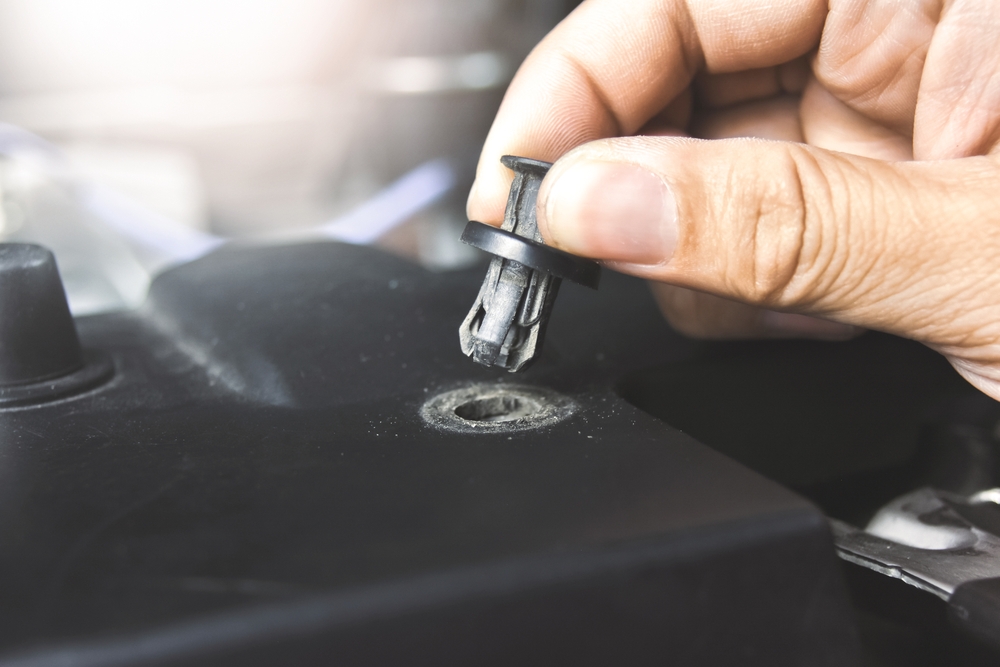The Different Types of Automotive Pins

When it comes to automotive clips and fasteners, we’ve got you covered. We understand that sometimes even a tiny part can hold up an entire project. With so many different types and styles to choose from, it can be difficult to figure out the perfect fastener for the job. Let's take a more in-depth look at some commonly used automotive pins and their uses.
Clevis Pins
Clevis pins are a simple cylinder with a flat or domed head on one end and a cross-hole bored through it on the other end. They are used as a quick and secure fastener that can take the place of bolts or rivets. Clevis pins are non-threaded fasteners that are often used in farming and towing, while their larger heavy-duty version (known as a shackle) is more common in construction and rigging. A clevis pin is used by inserting the pin through the holes at the pronged ends of a clevis, and it is often kept in place by a cotter pin. These pins provide a convenient attaching point for chain assembly components such as eye end fittings, tractor eye bolts, and other round assemblies.
Cotter Pins
A cotter pin is a fastener made from a single piece of metal bent into an elongated U shape with a ring or “head” at one end and two tines on the other. Also known as split pins, these pins are designed to be inserted into the hole of a bolt, and for the two tines on one end to be twisted together. This secures the bolt and makes it less likely to come loose or fall out. If you need to remove a cotter pin, simply twist the ends back to their original shape and pull them out of the hole. A pair of pliers might make this process easier for more heavy-duty cotter pins.
A hammer lock cotter pin is a specialized type of fastener that requires a hammer to install. These pins are curved on one end, with the end of the long prong curved inward toward the shorter prong. They can be fastened by inserting them into a hole and striking the head with a hammer. This will cause the ends of the prongs to close together, forming a secure hold on the bolt.
Metric cotter pins are a type of unthreaded fastener that can be inserted into a hole to keep another part in place. They are often used alongside clevis pins or nuts for a secure fit. Cotter pins have a rounded head and are split down the middle, allowing them to be squeezed to fit into a tight space and expand naturally once inserted. After the cotter pin is inserted into a hole, the ends of the pin are bent to secure the pin in place. At Clips and Fasteners, we supply DIN 94 metric cotter pins in stainless steel, unplated steel, and zinc-plated options.
Lynch Pins
Lynch pins, also called linch pins or hitch pins, are simple fasteners that play an important role in securing objects attached to an axle. Most commonly, lynch pins are used to prevent wheels from sliding off an axle. Lynch pins are simple and easy to use — simply place the object on the axle and insert the pin through the end of the axle, and the lynch pin will block the object from falling off or sliding.
Lynch PinsLynch pins, also called linch pins or hitch pins, are simple fasteners that play an important role in securing objects attached to an axle. Most commonly, lynch pins are used to prevent wheels from sliding off an axle. Lynch pins are simple and easy to use — simply place the object on the axle and insert the pin through the end of the axle, and the lynch pin will block the object from falling off or sliding.
Spring Pins
A spring-loaded pin is made of three main parts: a spring, a barrel, and a plunger. The spring allows the pin to compress by contracting inside the barrel when force is exerted on it. The plunger prevents the spring from expanding back to its normal size and pushing out when the spring is not locked into place. Once the spring pin is placed inside a hole, the pin is locked in place by the force of the spring attempting to expand back to its original size within the tiny space. This locks the pin in place, making a spring pin a self-retaining fastener. Zinc spring pins are the most common due to their flexibility, strength, and resistance to corrosion over time. They come in a wide array of different sizes and thicknesses, so you can find the perfect fit for any project.
Weld Pins
Weld pins are a very specialized type of pin used by mechanics and body shop technicians to help fix dents. These pins can be welded onto a damaged body panel of a car or truck, then pulled using a gripping device to help pull out a dent from the damaged area. Automotive weld pins are often made from copper-plated steel to ensure they have a strong heat-resistant core and that they can be easily welded to the vehicle thanks to the copper’s low melting point.
|
|
|